You CANNOT get a job offer from a prestigious consulting firm if you cannot organize and communicate your thoughts using the MECE principle.
But, use the MECE principle correctly, and you will:
- Solve complex problems like the ones you’ll have in case interviews.
- Communicate your ideas. For instance, during a fit or a case interview.
On the other hand, do NOT use the MECE principle correctly:
And you will fail your interviews (100% guarantee) and be blacklisted by the consulting firm of your dreams.
That’s why:
As an aspiring Consultant, it’s critical to show during your job interviews that you know the ins and outs of the MECE principle.
And that’s what you are going to learn in this article:
First, you will learn what the MECE principle is.
But more importantly:
You’ll learn how to (easily) use the MECE principle during your case and fit interviews…
To eventually land a job in Consulting.
Let’s start right now!
Table of Contents
Get the latest data about salaries in consulting
What is MECE?
MECE (pronounced me-see) is an acronym for Mutually Exclusive and Collectively Exhaustive.
The MECE principle (mutually exclusive and collectively exhaustive) is a grouping principle for separating a set of items into subsets that are mutually exclusive (ME) and collectively exhaustive (CE).
Here is a first MECE example:
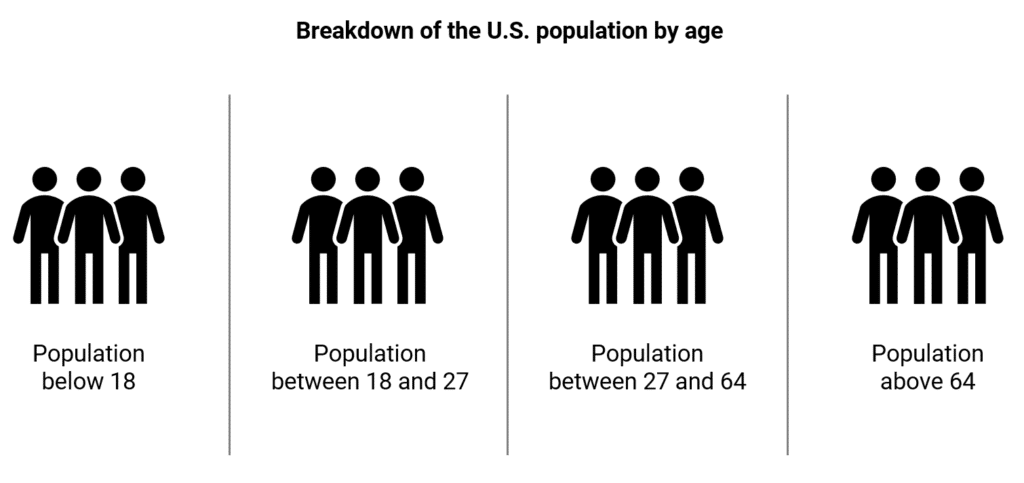
The above MECE example shows a MECE segmentation of the U.S. population by age.
In this MECE segmentation:
- There is no overlap (mutually exclusive): a person can be in only one group.
- There is no gap (collectively exhaustive): a person must be in only one group.
Now, let’s take another MECE example:

The above example shows a MECE segmentation of the world.
In other words:
This is a MECE breakdown of the world!
In this MECE segmentation:
- There is no overlap (mutually exclusive): a country can be in only one region.
- There is no gap (collectively exhaustive): a country must be in only one region.
Now, here are two non MECE examples:

In the above non MECE example on the left side:
There is an overlap (this is not mutually exclusive).
For instance, profits have declined because of the Diet Coke product line sold in the US markets.
In the above non MECE example on the right side:
There is a gap (this is not collectively exhaustive).
For instance, profits have declined in a market in the Asia region.
Those were two non-MECE examples.
Related article: 11 Must-know MECE Frameworks to ace your case interviews
Why is MECE important?
Strategy Consultants work, eat, drink, and sleep with the MECE principle.
When they have to solve a complicated problem, that’s when MECE will be most helpful.
How?
By breaking that problem into subproblems that are mutually exclusive (they don’t overlap) and comprehensively exhaustive (they cover all possibilities).
So, if you have spent time practicing for the case interview, you have learned how to develop MECE frameworks to structure your approach to the case.
The MECE principle is necessary for anyone considering joining the management consulting industry.
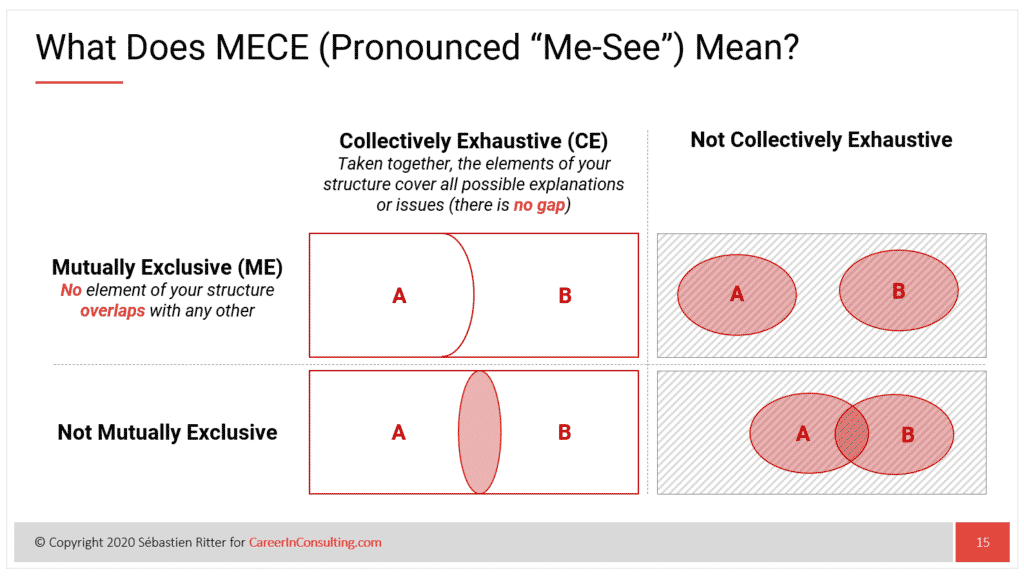
Strategy Consultants widely use the MECE principle for solving problems quickly and systematically.
They use the MECE framework to develop a clear thought process for solving a business problem.
In other words:
MECE frameworks are great tools for organizing complex ideas and solving complex problems.
The MECE principle supports their thinking process in two different ways:
The MECE principle is important to avoid duplicate work (no overlap)
Information categories should be grouped to prevent double counting so they do not overlap.
This is useful for organizing teamwork.
A team is responsible for a set of analyses.
While another team is responsible for a different set of analyses.
Hence, the two teams will not work on the same analyses by respecting the mutually exclusive principle.
The MECE principle is important to avoid missing something (no gap)
All categories combined should cover all potential options.
This helps prevent information from being missed.
The MECE principle explained with 2 examples
The idea behind the MECE principle is to keep information organized for:
- Solving complex problems as quickly as possible
- Communicating clearly ideas.
To explain the MECE principle, let’s take an example:
Imagine that you are a Consultant at McKinsey & Company.
And your actual project involves helping a leading US grocery retailer understand why their revenue has declined by 15% in the past 2 years.
First, a (bad) approach to solve the US retailer problem
To solve the above problem, you can brainstorm and make the following hypotheses:
#1. Has the revenue declined because of the growing competition?
#2. Has the revenue declined because of a change in consumer buying behavior?
#3. Has the revenue declined because of a bad macroeconomic situation?
#4. Has the revenue declined because of an issue in managing their inventory?
#5. Has the revenue declined because of declining sales in California (or another state)?
#6. Has the revenue declined because of a drop in Coca-Cola sales?
#7. Has the revenue declined because of the location of their stores?
The 2 problems with this list?
First, there might be a gap: the reason explaining the declining revenue is not listed.
In other words: this list is not collectively exhaustive.
For instance:
Has the revenue declined because of a cut in their marketing expenses?
Thus, the potential solution can be missed if you throw out a random list of ideas.
And the problem may not be solved.
Secondly, there might be an overlap: 2 of the solutions listed are not independent, and you perform the same analyses twice.
In other words: this list is not mutually exclusive.
For instance:
You analyze the sales in California – for all product lines, including Coca-Cola products – to check if the declining revenue comes from this specific region.
At the same time, another Consultant analyzes the revenue coming from the sales of Coca-Cola products – including the sales of Coca-Cola products in California – to check if the declining revenue comes from this specific line of products.
Do you see the problem?
A random list of ideas can lead to a duplication of work.
Secondly, a (good) approach to solve the US retailer problem
A better approach to the above problem would be categorizing the potential solutions into mutually exclusive and collectively exhaustive categories.
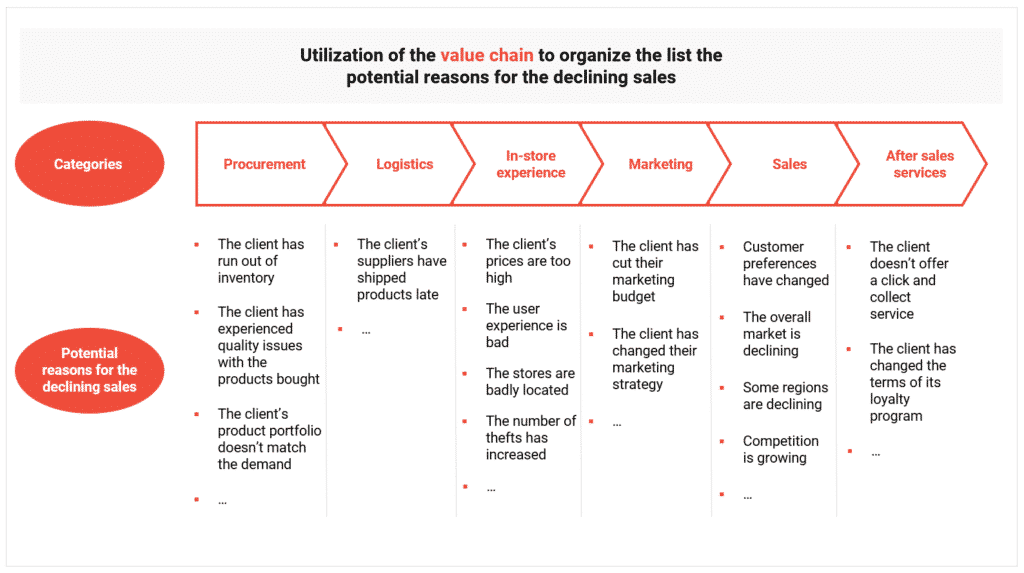
As you can see in the above MECE example, I have used (and adapted) the value chain to categorize the potential sources of the problem.
Thus, with an organized list of ideas, you’ll ensure that your plan to solve the problem has no gap or overlap.
A graphical representation of the MECE principle: the issue trees
Another powerful problem-solving tool is used by the Consultants from McKinsey, the Boston Consulting Group, or Bain & Company (collectively called MBB).
This tool enables all the Consultants working on a project to have a clear view of the problem and its main components.
Thus:
These Consultants share the same vision of what needs to be analyzed to solve the problem.
They know exactly what has been done and what hasn’t been done yet.
This powerful problem-solving tool is the issue tree.
An issue tree is a graphical representation of how you have organized your ideas (or your hypotheses, i.e., the potential solutions to the problem).

Each level of an issue should respect the MECE principle.
What does that mean for you?
You should use issue trees in your case interviews.
When you brainstorm, make hypotheses, and think about what you want to analyze to solve a problem: graphically represent the hierarchy of your ideas in an issue tree.
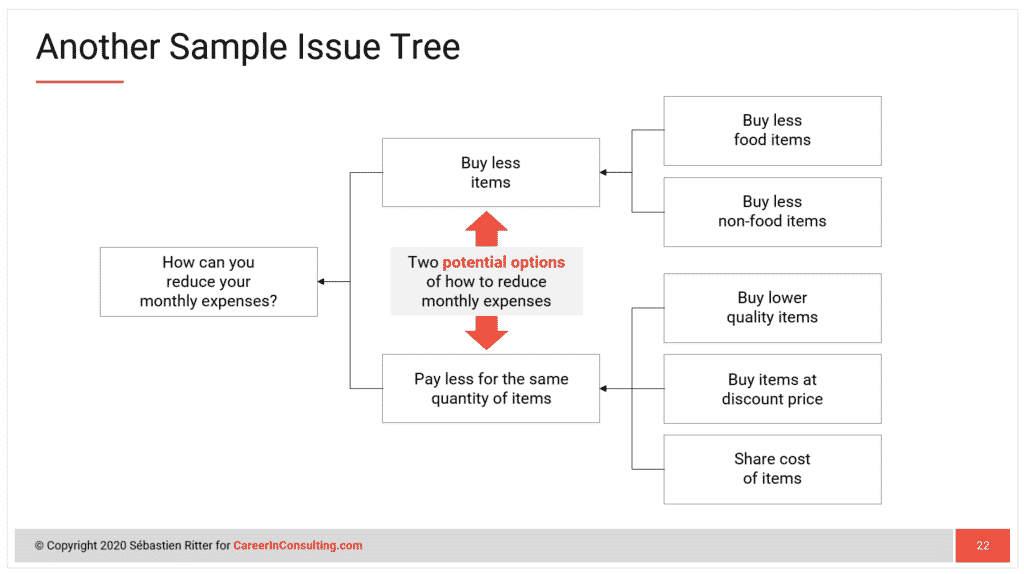
If you do so:
You’ll show your interviewers that you speak their language.
Plus:
A graphical representation of the problem and its components can help you identify potential gaps or overlaps in your approach.
Aren’t you confident that your issue trees are MECE?
Don’t worry:
You can do the MECE test described below.
With this simple test, you can determine whether all your issue trees are MECE.
Get 4 Complete Case Interview Courses For Free

You need 4 skills to be successful in all case interviews: Case Structuring, Case Leadership, Case Analytics, and Communication. Join this free training and learn how to ace ANY case questions.
Are your issue trees MECE? Do this simple test
There is a simple test to check if your issue trees are MECE.
With this simple test, you can assess if you have a MECE framework.
This test is simple because you only have to ask yourself 2 questions.
First, to test if 2 categories are collectively exhaustive, ask yourself:
‘Are there any other conditions that must be true to solve the parent problem?’
Secondly, to test if 2 categories are mutually exclusive, ask yourself:
’Can you change an issue independently from the other issues?’
Now, in the next section, I will show you some techniques to build issue trees that are MECE.
Solving complex problems with MECE frameworks
The MECE principle is a solid method to lay down the issue tree (the case structure or case interview framework) you will use to solve a problem in a case interview.
To lay down this structure, you have the choice between 2 options:
First, the static frameworks.
Secondly, the dynamic frameworks.
Let’s define what these 2 options mean and discuss the pros and cons of each in the next 2 sections.
The first way to organize your thoughts: the ‘static MECE frameworks’
The ‘static frameworks’ methodology is taught in well-known books such as ‘Case in Point’ (by Marc Consentino) or ‘Case interview secrets’ (by Victor Cheng).
In short, the methodology looks like this:
For a certain type of case, use the corresponding framework.
Some examples?
If you have a Market Entry case, use this framework: Market, Company, Competition, How to enter.
If you have a Profitability case, use this framework: Quantity, Price, Fixed Costs, Variable Costs.
If you have an M&A case, use this framework: Company A, Company B, Synergies, Risks.
… and this goes on for a dozen of different types of cases.
The main advantage of this methodology?
This methodology is pretty simple.
You only have to memorize frameworks and the questions to ask the interviewers.

What are the disadvantages of this methodology?
There are plenty.
First, static frameworks are destroying your creativity.
An example?
What happens if you have a case like this (it was the case I got at my 4th interview at BCG):
Your client is the CEO of a big corporation. The CEO wants to internalize a training program for the company’s top 100 managers. The training program is today outsourced to an external supplier. What do you suggest?
There is no MECE framework to solve this problem in the 2 books mentioned above.
And if you try to force-fit one of the well-known static frameworks, the interview will be a disaster.
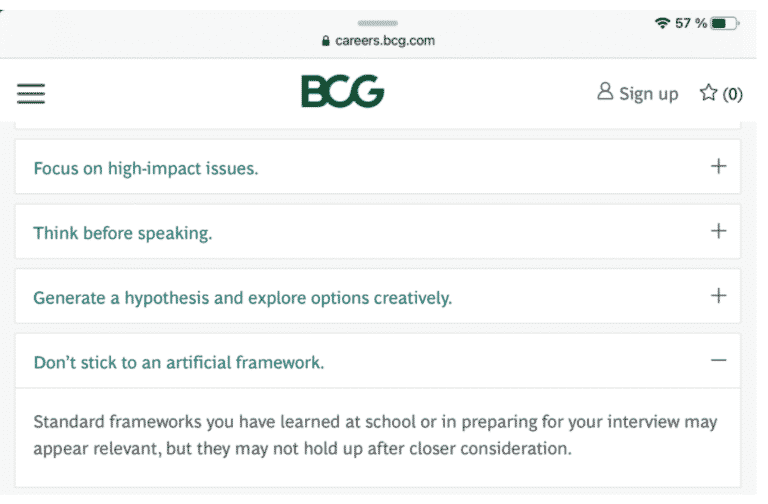
But, in my opinion, the main problem with this methodology is something else.
The main problem?
ALL candidates know these frameworks.
Therefore, you can NOT differentiate yourself if you use the same approach and materials as other candidates.
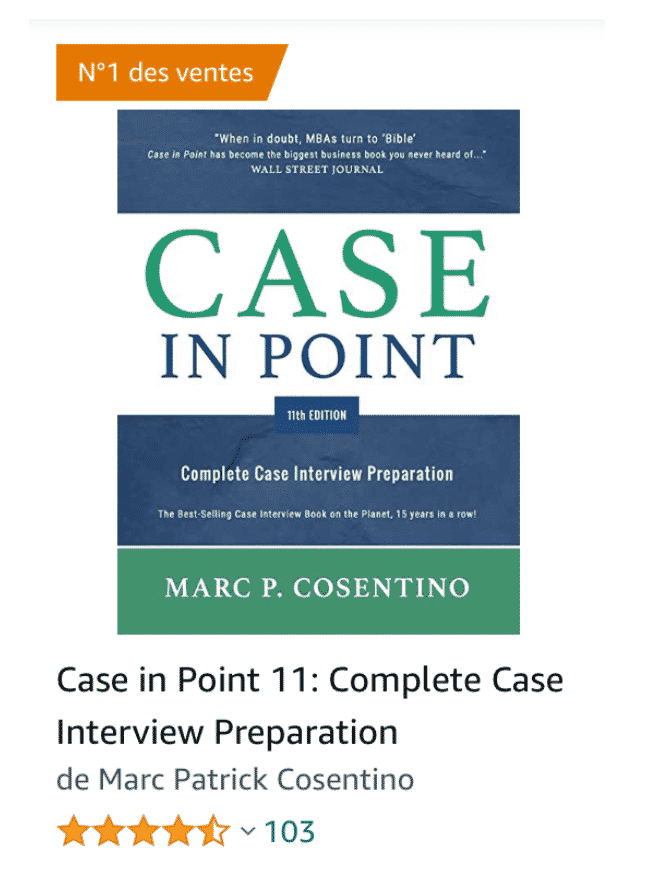
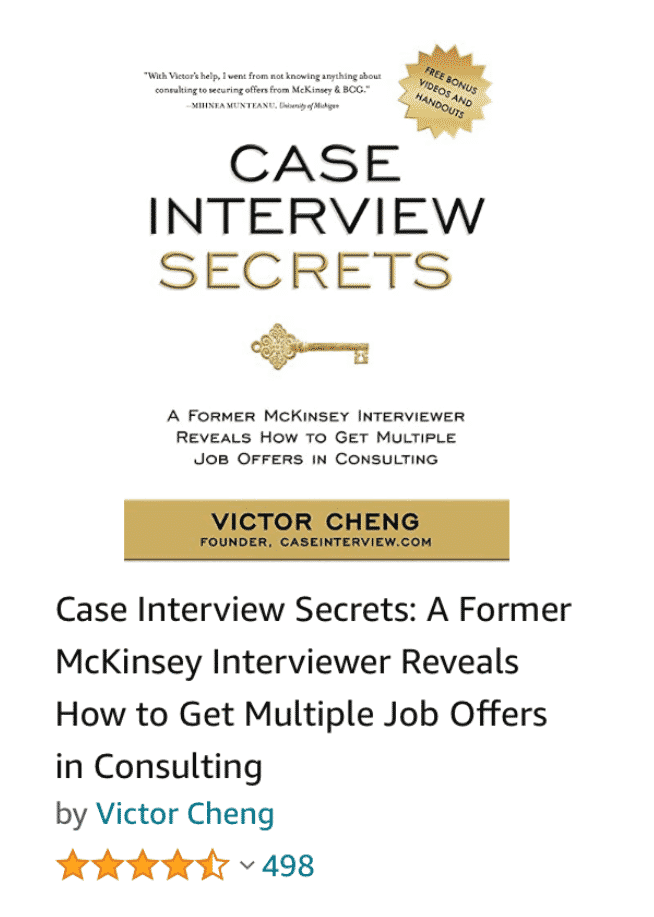
The second way to organize your thoughts: the ‘dynamic MECE frameworks’
The ‘dynamic frameworks’ methodology teaches you how to develop your own case structures.
A first example?
One of these dynamic framework techniques consists of leveraging the properties of an arithmetic equation.
For instance, imagine that you have to understand why the sales of an Airline company have been decreasing…
To do so, you can breakdown the sales of an Airline company into an equation:
Here, the causes of the sales decline can be either the declining number of passengers or the declining ticket price per passenger (or both).
A second example?
Another dynamic framework technique involves breaking down a process into its logical steps.
For instance:
Imagine you want to discover why a leading car manufacturer’s productivity (the number of cars produced per hour) is declining.
To do so, you can break down the manufacturing process into its logical steps and, for each step, check if (and why) the productivity declined.
Procurement > Assembly > Paint & Coatings > Shipping
What do I think of the ‘dynamic frameworks’ methodology?
This methodology is better than the previous one.
Because this methodology does NOT destroy your creativity:
For instance, you can mix some of these MECE techniques to develop more ideas than the average candidate.
Plus, your creativity is not constrained by a limited list of frameworks to use or questions to ask.
Therefore, you can develop your own frameworks to solve ‘uncommon’ cases – like the one above, which I had at my 4th interview at BCG.
Plus, I believe this methodology must be mastered by candidates serious about landing a job in Consulting.
Communicating clearly your ideas using the MECE principle: The Pyramid Principle
Consultants use the MECE principle (mutually exclusive, collectively exhaustive) to solve problems and communicate their ideas.
The pyramid principle was developed by Barbara Minto, the first woman to become a Partner at McKinsey & Company.
This is a structured way to communicate your ideas.
For instance: your recommendation to a CEO.
The main idea behind the pyramid principle is to communicate the most important idea first.
Then, you communicate the main arguments – organized with the MECE principle – that support the most important idea.

Why is this important?
Because when you talk to a CEO, you must bring across the most important messages as quickly as possible.
Due to time constraints, the CEO is primarily interested in the solution to their problem and not in the process behind this solution.
But the pyramid principle goes beyond just talking to a CEO and must be used throughout your interviews.
First, of course, when you present your recommendation at the end of a case interview.
But also when you present your achievements during your fit interviews.
For instance, at McKinsey, you can have a question such as:
‘Describe a time when you’ve had to work with someone with an opposing opinion.’
To answer this question, you can use the STAR framework and present the actions you did to solve the problem using the MECE principle.
Thus, you’ll send a positive signal:
You can present in front of an audience of executives.
The pyramid principle is such an important concept that I strongly recommend you buy this book from Barbara Minto.
In the meantime, you can watch the following two videos.
The MECE principle: final thoughts
MECE stands for mutually exclusive, collectively exhaustive.
The MECE principle is a thought process that keeps ideas from being muddled up.
In other words:
This is a way to segment information into Mutually Exclusive and Collectively Exhaustive categories.
That’s why:
First, in the short term, the MECE principle will help you land a job in the consulting firm of your choice.
Plus, the MECE principle will help you become a better problem solver and communicator in the long term.
Now it’s your turn!
Leave a comment and tell me what techniques you use to be MECE.
Best,
Sébastien
P.S. Do you need help with building MECE issue trees?
Do you want to ace your case interviews and secure an offer?
Check this page to see how our unique coaching model can help you land a job at your dream consulting firm.
Besides, you can sign up for the free training hereafter.
In this free training, you’ll learn how to develop MECE frameworks quickly!
Get 4 Complete Case Interview Courses For Free

You need 4 skills to be successful in all case interviews: Case Structuring, Case Leadership, Case Analytics, and Communication. Join this free training and learn how to ace ANY case questions.
SHARE THIS POST

awesome work keep it up.
Thanks Kevin